|
 
 |
| ORIGINAL ARTICLE |
|
| Year : 2015 | Volume
: 3
| Issue : 2 | Page : 42-46 |
|
Anthropometric study of canthal and circumference interorbital indices among young Urhobo adults in South-South Nigeria
Dennis E. O. Eboh, Eloho O Ogbor-Omorie, Justina O Dibie
Department of Human Anatomy and Cell Biology, College of Health Sciences, Delta State University, Abraka, Nigeria
| Date of Web Publication | 14-Jan-2016 |
Correspondence Address:
Dr. Dennis E. O. Eboh
Department of Human Anatomy and Cell Biology, Faculty of Basic Medical Sciences, College of Health Sciences, Delta State University, PMB 1, Abraka
Nigeria
 Source of Support: None, Conflict of Interest: None  | Check |
DOI: 10.4103/2315-7992.173983

Background: Craniofacial anthropometric parameters have been found to be relevant in anthropology as well as clinical and surgical practices. Aim: The aim of this study was to determine the canthal and circumference interorbital indices among young Urhobo adults, in South-South Nigeria. Materials and Methods: The simple random sampling technique was adopted in this descriptive anthropometric study that involved 601 participants. Inner and outer canthal distances were measured using the nonstretchable plastic centimeter ruler while the nonstretchable tailor tape was used for measurement of the head circumference. Canthal and circumference interorbital indices were calculated based on standard formulae. Statistical Analysis: Statistical analysis was done using descriptive and inferential statistics, with the aid of the statistical package of social sociences, version 20. P value ≤ 0.05 was considered to be statistically significant. Results: Results showed that all linear dimensions for males were significantly higher than females. There were no significant gender differences regarding the canthal and circumference interorbital indices. Canthal index-inner canthal distance, circumference interorbital index-inner canthal distance, circumference interorbital index-head circumference, and circumference interorbital index-canthal index correlations were significant (P < 0.05) while canthal index-outer canthal distance correlation was not significant (P > 0.05). Conclusion: There were no significant gender differences regarding canthal and circumference interorbital indices. Keywords: Canthal index, circumference interorbital index, Nigeria, Urhobo ethnic group
How to cite this article:
Eboh DE, Ogbor-Omorie EO, Dibie JO. Anthropometric study of canthal and circumference interorbital indices among young Urhobo adults in South-South Nigeria. Ann Bioanthropol 2015;3:42-6 |
How to cite this URL:
Eboh DE, Ogbor-Omorie EO, Dibie JO. Anthropometric study of canthal and circumference interorbital indices among young Urhobo adults in South-South Nigeria. Ann Bioanthropol [serial online] 2015 [cited 2018 Jan 23];3:42-6. Available from: http://www.bioanthrojournal.org/text.asp?2015/3/2/42/173983 |
| Introduction | |  |
Anthropometry, a subset of anthropology, is concerned with measurements of the human body. [1] It is associated with physical differences, especially as it pertains to skeletal and racial groups. Canthal and circumference interorbital indices are important parameters in craniofacial anthropometry. Several literatures containing varied values of these parameters for various populations exist due to age, gender, and differences in ethnicity. Studies on canthal and circumference interorbital indices have been conducted previously. [2],[3],[4],[5],[6],[7] Also, only a few Nigerian studies [8],[9],[10] reporting the normative values for the selected parameters (head circumference, inner canthal distance, outer canthal distance) have been conducted.
Furthermore, only a handful of research literatures containing circumference interorbital index for a Nigerian population exist. [11],[12],[13],[14] On the other hand, there are various studies on the canthal index in a Nigerian population. [8],[9],[13],[14],[15],[16],[17],[18],[19]
In spite of the fact that studies on canthal and circumference interorbital indices abound, including in Nigeria, the literature is lacking as these studies have not been conducted among the Urhobo people. This gap in the literature is what this study intends to fill. Lack of normative data for these indices may militate against clinical assessment of the appropriate craniofacial deformities in the study population.
This study will provide normative data of the head circumference, inner and outer canthal distances, canthal index, and circumference interorbital index, which are useful for anthropology, craniofacial surgery as well as the evaluation and treatment of congenital or posttraumatic deformities of the craniofacial regions. Examples of such traumatic deformities are telecanthus, ocular hypertelorism, and craniosynostosis. The aim of this study was to determine canthal and circumference interorbital indices among the Urhobo people of Nigeria, aged 18-30 years.
| Materials and Methods | |  |
Study design
This was a descriptive anthropometric study conducted between Februray 2012 and August 2012.
Study population
The study population comprised all students of the Urhobo ethnic group, aged 18-30 years in the Delta State University, Abraka, Delta State, Nigeria.
Sampling technique
The sample had 601 subjects, 313 males and 288 females, and the mean age was 21.99 years using the simple random sampling technique.
Ethical issues
Prior to measurement, informed consent was obtained from the subject in accordance with the international ethical standard. [20]
Measurement of parameters
The following measurements were carried out:
- The inner canthal distance was measured by making the subject look straight horizontally toward the examiner in an anatomical position while sitting in a chair
- In the case of the outer canthal distance, the subject was asked to look upward in order to maximize the contrast (minimize the error) between the sclera and the skin
- Inner and outer canthal distances were measured between the two medial and two lateral angles of the palpebral fissures, respectively, using the nonstretchable plastic centimeter ruler held tightly against the bridge of the subject's nose [Figure 1]. This method is in accordance with previous studies [7],[21]
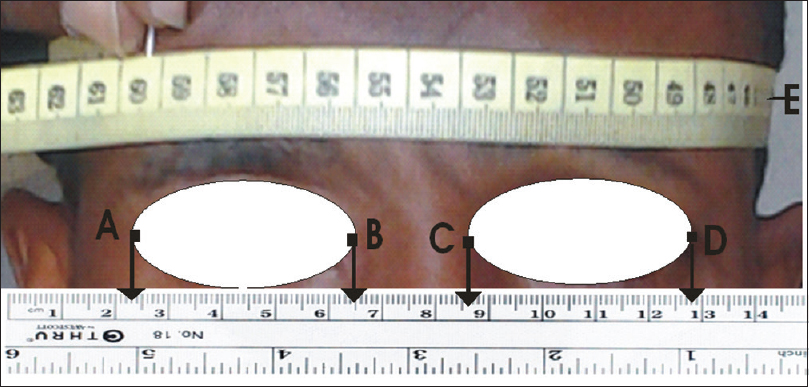 | Figure 1: Measurements of head circumference and canthal distances E=Head circumference; BC=Inner canthal distance; AD=Outer canthal distance
Click here to view |
- Head circumference was measured by placing the nonstretchable tailor tape from the occipital prominence to the supraorbital bridge [Figure 1]. Each subject was seated comfortably in a chair with the subject's head at the same level as the examiner's head.
Selection criteria
Subjects were selected if they met the following criteria: no history of craniofacial trauma, surgery, or congenital anomaly and no clinical evidence of telecanthus or epicanthus. In addition, parents of the subjects up to the second generation had to be Urhobo.
Calculation of the indices
The indices were calculated as follows:
- Canthal index = (inner canthal distance ÷ outer canthal distance) ×100
- Circumference interorbital index = (inner canthal distance ÷ head circumference) ×100.
The data obtained were subjected to statistical analysis using descriptive and inferential statistics, with the aid of the statistical package of social sociences, version 20. P value ≤ 0.05 was considered to be statistically significant.
| Results | |  |
The mean craniofacial dimensions are summarized in [Table 1]. Sexual differences were observed with regard to inner canthal distance, outer canthal distance, and head circumference, which were found to be significantly larger in males compared to females (P < 0.05). The mean circumference, interorbital index, and canthal index were observed to be larger in males compared to females but the differences were not statistically significant (P > 0.05).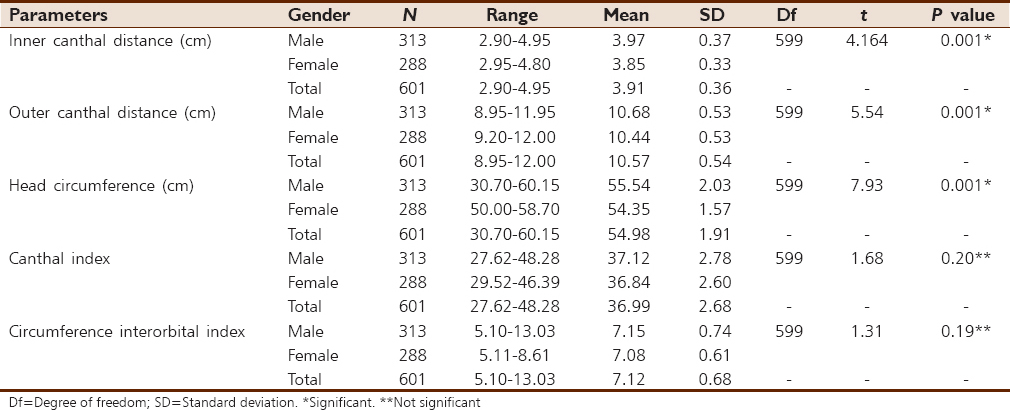 | Table 1: Results of descriptive statistics of parameters and t-tests between genders
Click here to view |
Correlation coefficient between the canthal index and canthal distances are shown in [Table 2]. Correlation coefficient between the canthal index and inner canthal distance was found to be very high, positive, and significant, indicating a strong relationship between the two parameters. Correlation between the canthal index and outer canthal distance was observed to be very poor and statistically not significant. The correlation coefficient between the circumference interorbital index and canthal index was found to be very strong, positive, and statistically significant, hence indicating a strong relationship [Table 2]. Correlation coefficient between the circumference interorbital index and inner canthal distance and head circumference are also depicted in [Table 2]. Correlation coefficient between circumference interorbital index and inner canthal distance was found to be very high, positive, and statistically significant while it was very low, negative, and statistically significant in the case of correlation coefficient between the circumference interorbital index and head circumference.
[Figure 2] and [Figure 3] show scatter plots and fit lines demonstrating relationships between the canthal index and inner canthal distance and outer canthal distance, respectively. [Figure 4], [Figure 5], [Figure 6] show scatter plots and fit lines demonstrating relationships between circumference interorbital index and inner canthal distance, and head circumference and canthal index, respectively.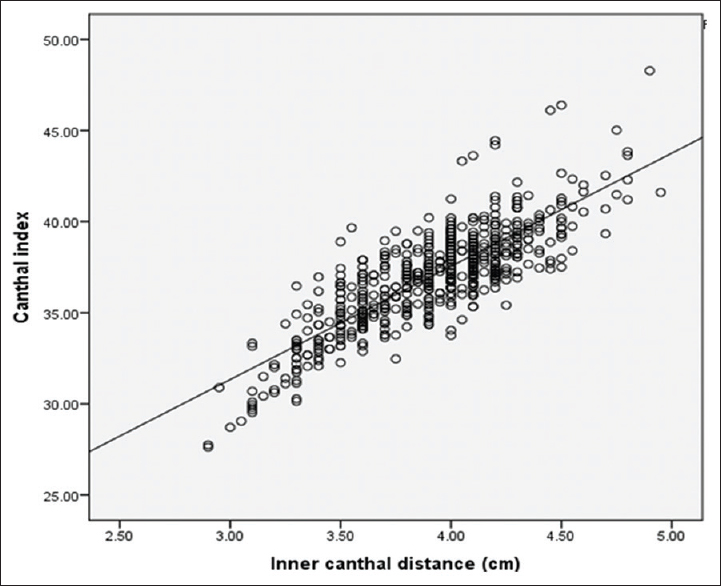 | Figure 2: Scatter plots showing the relationship between canthal index and inner canthal distance
Click here to view |
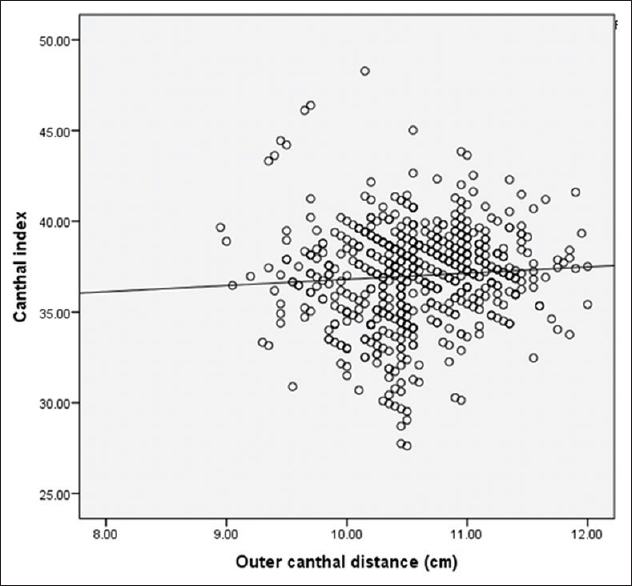 | Figure 3: Scatter plots showing the relationship between canthal index and outer canthal distance
Click here to view |
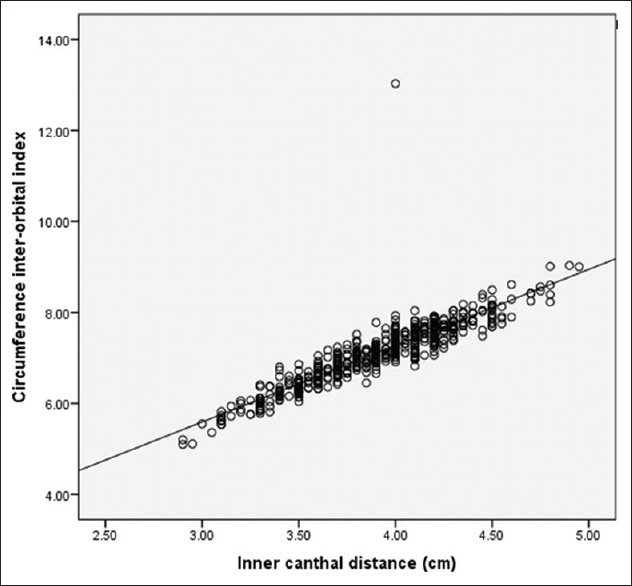 | Figure 4: Scatter plots showing the relationship between circumference interorbital index and inner canthal distance
Click here to view |
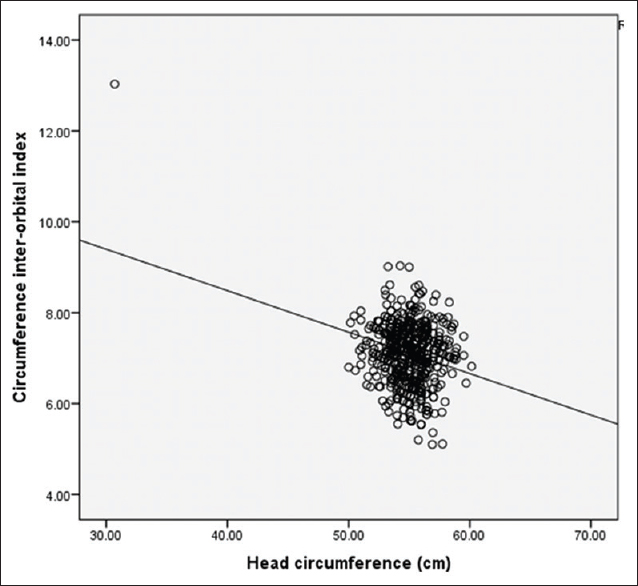 | Figure 5: Scatter plots showing the relationship between circumference interorbital index and head circumference
Click here to view |
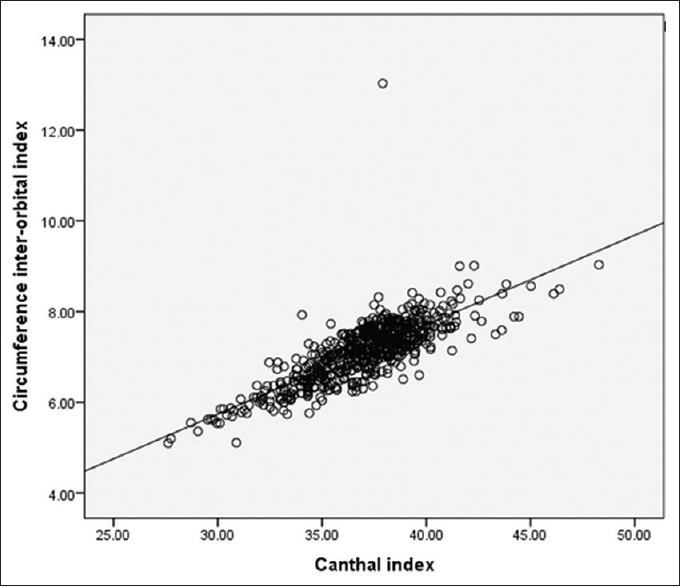 | Figure 6: Scatter plots showing the relationship between circumference interorbital index and canthal index
Click here to view |
| Discussion | |  |
In the present study, male values for inner canthal distance, outer canthal distance, head circumference, canthal index, and circumference interorbital index were higher and this report is in line with the reports of some previous studies [2],[9],[11],[13],[15],[16],[21] but at variance with others. [4],[8],[12]
Sexual differences with regard to inner canthal distance, outer canthal distance, and head circumference were found to be significantly larger in males (P < 0.05). However, the mean circumference interorbital index and canthal index were observed to be larger in males but sexual differences were not statistically significant (P > 0.05). This result disagrees with previous similar studies [12],[13],[15],[22] where statistically significant sexual differences (P > 0.05) were observed.
In similar studies, [2],[14] there were no significant differences (P < 0.05) between males and females in the linear measurements. Genetics and environmental factors could be responsible for the variations observed.
The correlation of indices studied and their respective linear dimensions is linear, positive, and significant if the index is directly related to the linear dimension. It may therefore, suggest that there is the same directional change in canthal index and circumference interorbital index for every growth change in inner canthal distance. However, canthal index-outer canthal distance with inverse relationship has a poor correlation coefficient while circumference interorbital index-head circumference also with inverse relationship has low and negative correlation coefficient, suggesting that an increase in growth of head circumference predicts a decrease in the circumference interorbital index. Interestingly, there is high positive relationship between canthal and circumference interorbital indices, indicating the same directional change.
| Conclusion | |  |
From the findings obtained in this study, all linear dimensions (inner canthal distance, outer canthal distance, and head circumference) show that male is significantly higher than female. There were no significant gender differences regarding canthal and circumference interorbital indices. Canthal index-inner canthal distance, circumference interorbital index-inner canthal distance, circumference interorbital index-head circumference, and circumference interorbital index-canthal index show a significant correlation (P < 0.05) while the correlation coefficient of canthal index-outer canthal distance was not significant (P < 0.05).
Acknowledgements
We wish to thank all the study subjects for their cooperation and the respective heads of schools for granting the permission to conduct the study.
Financial support and sponsorship
Nil.
Conflicts of interest
There are no conflicts of interest.
| References | |  |
| 1. | Donald RA, Douglas RB, John B. Anthropometry. In: Tilley LP, Smith WK, Allen D, editors. Stedman′s Medical Dictionary. 27 th ed. Lippincott Williams and Wilkins; 2003. p. 95.  |
| 2. | Vasanthakumar P, Kumar P, Rao M. Anthropometric analysis of palpebral fissure dimensions and its position in South Indian ethnic adults. Oman Med J 2013;28:26-32.  |
| 3. | Evereklioglu C, Yakinci C, Er H, Doganay S, Durmaz Y. Normative values of craniofacial measurements in idiopathic benign microcephalic children. Cleft Palate Craniofac J 2001;38:260-3.  |
| 4. | Juberg RC, Sholte FG, Torchstone WJ. Normal values for intercanthal distances of 5- to 11-year-old American blacks. Pediatrics 1975;55:431-6.  |
| 5. | Evereklioglu C, Dogany S, Er Z, Gunduz A, Tercan M, Balat A, et al. Craniofacial anthropometry in Turkish population. Cleft Palate Craniofac J 2002;39:208-18.  |
| 6. | Pivnick EK, Rivas ML, Tolley EA, Smith SD, Presbury GJ. Interpupillary distance in a normal black population. Clin Genet 1999;55:182-91.  |
| 7. | Laestadius ND, Aese JM, Smith DW. Normal inner canthal and outer orbital dimensions. J Pediatr 1969;74:465-8.  |
| 8. | Jaja BN, Fawehinmi HB, Jack JT. Craniofacial anthropometry in a young Nigerian population: The Canthal distances. Int J Morphol 2011;29:914-7.  |
| 9. | Oladipo GS, Okoh PD, Hart JS. Anthropometric study of ocular dimensions in adult ijaws of Nigeria. Res J Med Med Sci 2010;5:121-4.  |
| 10. | Singh JR, Banerjee S. Normal values of interpupillary, inner canthal and outer canthal distances in an Indian population. Hum Hered 1983;33:326-8.  [ PUBMED] |
| 11. | Anibor E, Ogbor-Omorie E, Ogadima PN. The circumference inter-orbital index of the Isoko ethnic group in Nigeria. Afr J Cell Pathol 2014;3:1-4.  |
| 12. | Chukwujekwu IE, Ezejindu DN, Aduwenye OI. Study of head circumference inter orbital index between the ages of 19-29 years of Igbo Tribes in Otolo, Okofia, Nnewi, Anambra State, Nigeria. Int J Res 2014;1:239-44.  |
| 13. | Oladipo GS, Yorkum LK, Okoh PD. Measurements of head circumference, intercanthal distances, canthal index and circumference interorbital index of Ikwerre school children in Nigeria. J Nat Sci Res 2013;3:16-20.  |
| 14. | Osunwoke EA, Elekwa A, Bob-Manuel IF, Ojeka SO. A study on the normal values of inner canthal, outer canthal, canthal index, interpupillary distance and head circumference of 23-42 years Igbos. Global J Med Sci 2010;9:1-2.  |
| 15. | Oladipo GS, Akande PA, Osogba IG, Yorkum KL. Anthropometric studies of inner canthal distance, outer canthal distance and canthal index of adult Ibibios. Asian J Med Sci 2011;3:14-6.  |
| 16. | Gabriel O, Fawehinmi HB, Peter O. Canthal indices of Urhobo and Itsekiri ethnic groups. Aust J Basic Appl Sci 2009;3:3093-6.  |
| 17. | Oladipo GS, Olotu E, Guinireama IU. Anthropometric comparison of canthal indices between the Ijaw and Igbo tribes. Sci Afr 2008;7:141-4.  |
| 18. | Anas I. Facial Anthropometry of the Hausa and Yoruba Ethnic Groups. Sokoto: Department of Anatomy, Usman Dan Fodio University; 2008.  |
| 19. | Ligha AE, Fawehinmi HB. Canthal and Cephalic indices of Nigerian children. Aust J Basic Appl Sci 2011;5:3107-11.  |
| 20. | |
| 21. | Esomonu UG, Akpuaka FC, Anibeze CIP. Anthropometric variations of inner and outer canthal distance of the Igbo of South-Eastern Nigeria. J Exp Clin Anat 2011;10:9-14.  |
| 22. | Oladipo GS, Ugboma A, Oyakhre MO. The circumference inter orbital index of jaw and Igbo ethnic groups in Nigeria. Int J Biol Anthropol 2009;3.  |
[Figure 1], [Figure 2], [Figure 3], [Figure 4], [Figure 5], [Figure 6]
[Table 1], [Table 2]
|